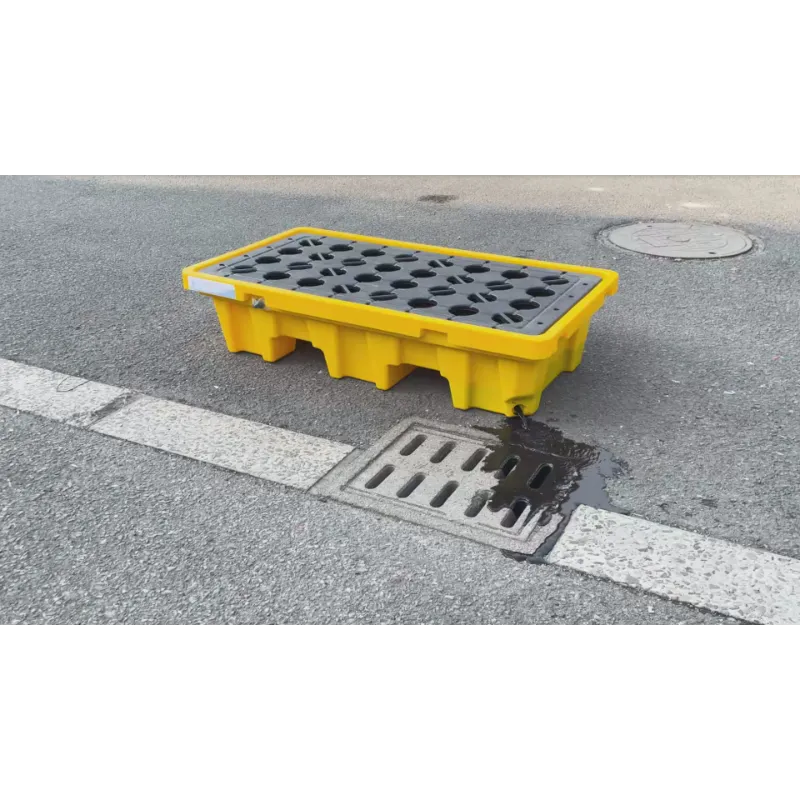Introduction
Spill containment pallets play a crucial role in environmental safety and compliance when storing hazardous chemicals. However, not all spill pallets provide the same level of protection. Spill pallets with drain plugs pose significant risks due to the potential for leaks and failures, making them unsuitable for hazardous chemical storage. Instead, seamless spill containment pallets offer superior reliability and compliance with regulations such as the Oil Storage Regulations 2001 (UK) and GPP26 (UK & Ireland), both of which enforce strict containment measures.
This article explores the risks associated with drain plug spill pallets, regulatory requirements, and why choosing a seamless spill containment solution is the best practice for hazardous chemical storage.
The Risks of Spill Pallets with Drain Plugs

Spill pallets with drain plugs are designed for easy drainage of collected spills. However, they present significant safety hazards when used for hazardous chemicals:
Leakage Risk
Drain plugs are manually fixed and can loosen over time due to vibrations, temperature fluctuations, or improper sealing, leading to potential chemical leaks.
Human Error
If a drain plug is left partially open or improperly closed, hazardous substances may escape, causing contamination and safety risks.
Degradation Over Time
Frequent opening and closing of drain plugs can wear down the sealing mechanism, making the spill pallet less effective at containing dangerous liquids.
Environmental Contamination
Any failure in the drain plug system increases the risk of hazardous chemicals reaching soil, waterways, and public areas, resulting in legal and financial consequences.
Direct Contact with Hazardous Chemicals
When draining hazardous liquids from a spill pallet, manually opening the drain plug can result in direct exposure to toxic substances, leading to skin burns, chemical inhalation, or other serious health risks.
For these reasons, seamless spill containment pallets, which eliminate the need for drain plugs, provide a more secure and reliable containment solution.
EPA SPCC (40 CFR 112) and Its Limitations for Chemical Storage
The EPA Spill Prevention, Control, and Countermeasure (SPCC) rule (40 CFR 112) is one of the most commonly referenced regulations for spill containment. However, this rule primarily applies to oil storage and does not fully address the risks of hazardous chemical containment. If companies store dangerous chemicals under SPCC guidelines, they may still face leakage issues, regulatory penalties, and worker safety hazards.
In contrast, Oil Storage Regulations 2001 (UK) and GPP26 (UK & Ireland) explicitly prohibit secondary containment with drainage outlets, ensuring better spill protection for hazardous substances.
Relevant Regulatory Clauses
GPP26 (UK & Ireland): “The secondary containment must not have any drainage. There can be no drainage outlet from your secondary containment. Any liquid should be pumped or bailed out in a controlled way.”
Oil Storage Regulations 2001 (UK): Prohibits any drainage outlets in bunded containment to prevent environmental contamination.
For full compliance and safety, hazardous chemicals should always be stored in sealed, seamless spill containment systems.
Regulatory Compliance: Oil Storage Regulations 2001 and GPP26
Both the Oil Storage Regulations 2001 (UK) and GPP26 (UK & Ireland) have strict requirements for secondary containment to prevent environmental contamination. These regulations emphasize the importance of fully sealed containment systems.
Oil Storage Regulations 2001 (UK)
No Uncontrolled Drainage: The regulation prohibits any outlet, valve, or drain that could allow spillage into the environment.
Regular Inspection and Maintenance: Storage facilities must ensure that their containment solutions are structurally sound and free from potential leak points.
GPP26 (UK & Ireland)
Mandatory Leak-Proof Containment: GPP26 requires that spill containment systems be fully sealed and constructed from materials resistant to the stored chemicals.
Drainage Restrictions: Any spill containment system must not have unsealed drains or openings that could compromise its containment capability.
Environmental Protection Focus: Businesses must implement best practices to eliminate risks of hazardous chemical spills, including the use of seamless spill containment pallets.
These regulations make it clear that spill pallets with drain plugs do not meet compliance standards, as they introduce an unnecessary risk of leaks and spills.
Why Seamless Spill Containment Pallets Are the Better Choice
Seamless spill containment pallets provide superior protection for hazardous chemical storage by eliminating the risks associated with drain plugs. Key benefits include:
100% Leak-Proof Design
With no drain plug to fail or loosen, seamless pallets ensure complete containment of hazardous substances.
Stronger Structural Integrity
The absence of drilled holes or openings reduces weak points that could degrade over time.
Regulatory Compliance
Meets strict containment requirements of Oil Storage Regulations 2001 and GPP26.
Enhanced Workplace Safety
Reduces the risk of accidental spills, protecting employees from chemical exposure.
Lower Maintenance Costs
No drain plugs to monitor, replace, or reseal, resulting in less upkeep and long-term cost savings.
For businesses handling hazardous chemicals, choosing seamless spill containment pallets is a proactive step toward safety, compliance, and environmental responsibility.
Legal Consequences and Real-World Violations
Using spill containment pallets with drain plugs not only increases the risk of leaks but also exposes businesses to serious legal and financial consequences. There have been multiple cases of fines and penalties imposed on companies for failing to use fully sealed secondary containment.
Examples of Penalties and Violations
UK-based chemical manufacturer fined £50,000 for using drain-plugged spill pallets, leading to hazardous waste entering stormwater drains.
Ireland’s Environmental Protection Agency (EPA) issued multiple citations for non-compliant secondary containment with drainage outlets, requiring costly facility upgrades.
US company faced regulatory action under SPCC rules after drain plug failure resulted in a major chemical spill, costing the company over $200,000 in fines and cleanup expenses.
For documented case studies and regulations, refer to official sources:
GPP26 (UK & Ireland) Full Guidelines: https://www.netregs.org.uk/environmental-topics/guidance-for-pollution-prevention-gpp-documents/gpp-26-safe-storage-drums-and-intermediate-bulk-containers/
Oil Storage Regulations 2001: https://assets.publishing.service.gov.uk/media/5a789bf2ed915d07d35b1066/pb5765-oil-storage-011101.pdf
EPA SPCC Rule: https://www.ecfr.gov/current/title-40/chapter-I/subchapter-D/part-112?toc=1
Conclusion: Choose Safety and Compliance Over Convenience

Spill pallets with drain plugs might seem convenient for drainage, but their risks far outweigh their benefits when dealing with hazardous chemicals. The potential for leaks, human error, and environmental damage makes them an unsafe choice.
Regulatory frameworks such as the Oil Storage Regulations 2001 and GPP26 have made it clear that spill containment solutions must be fully sealed and leak-proof to prevent contamination. Businesses should invest in seamless spill containment pallets, which offer superior safety, regulatory compliance, and long-term cost savings.
By eliminating the risks associated with drain plug failure, companies can ensure a safer workplace, avoid legal penalties, and contribute to environmental sustainability.
For full compliance and maximum safety, always choose seamless spill containment pallets for hazardous chemical storage.

